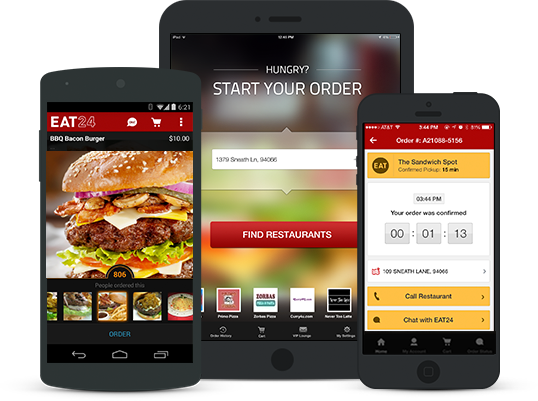
Another acquisition for Yelp that will take the local listings company even deeper into commerce and food-related services. It’s gobbling up Eat24, a U.S. food delivery business that competes with GrubHub, Delivery.com and others in the area of delivering food on behalf of various restaurants. Yelp is paying $134 million for Eat24, with $75 million in cash and the rest in Yelp shares, for the company.
The thinking is that this acquisition should help Yelp in two areas. First of all, it will give the company more contact points with restaurants. And second of all, it will help the company shore up its core listings business with another revenue stream.
In the first of these, Yelp already provides users with local listings for restaurants that they might want to visit. It also gives them the option of booking tables at those restaurants (by way of a 2013 acquisition of SeatMe), and it offers deals at those venues. Now it will give users the option of eschewing the restaurant experience altogether, instead ordering their food and having it brought directly to wherever they are.
“As more food ordering transactions move online, further integrating Eat24 will enhance our user experience with an easy-to-use product and service that allows our large consumer audience to transact directly with businesses,” said Jeremy Stoppelman, Yelp co-founder and chief executive officer, in a statement. “Eat24 has developed a great solution and unique service that has already added great value to the Yelp Platform. With this acquisition, we gain more tools and expertise to help engage our users from discovery through transaction in a key vertical for Yelp.”
Eat24 currently has about 20,000 restaurants on its platform across 1,500 cities, and it looks like it was bootstrapped according to Crunchbase.
The other area where this will be important is in Yelp’s bigger business. The company last week reported Q4 earnings that beat Wall Street expectations on net income of $32.7 million. Active local business accounts are now at 93,700, and local advertising accounts are 84,000. The number of restaurants on its listings platform currently numbers one million.
This speaks to existing competition from the likes of Foursquare and Google, but also the likes of Facebook, which continues to look for ways of digging deeper into local listings and potentially local commerce.
This means that Yelp will need to continue to find ways of making its proposition to local merchants compelling to keep them on its platform, and at the same time the company needs to continue to think of ways to get consumers to open its app, even if they’re not planning to move no further from their sofas than the front door (to pick up their takeaway).
Yelp currently has 135 million average monthly users, with 72 million average monthly uniques on mobile.
In terms of the bigger picture for online food delivery, it’s also interesting to see Eat24 going to Yelp, and for Yelp to be moving into this space. Globally, and in the U.S., there has been a big push towards consolidation, with many players like GrubHub and Seamless, DeliveryHero and JustEat coming to the conclusion that the thin margins on delivery services can only be improved with economies of scale. Let’s see how and if Yelp can square that with more services for target segments, rather than just going for a larger landgrab.
As a result of the deal, Yelp revised up its earnings for Q1 and the full year. For Q1 2015, Yelp is increasing its revenue outlook and expects net revenue to be in the range of $118.5 million to $120.5 million. For the full year 2015, Yelp is increasing its revenue outlook and expects net revenue to be in the range of $574 million to $579 million. Yelp’s currently trading 7% up at $45.29/share in the wake of the news.
Comments
Post a Comment